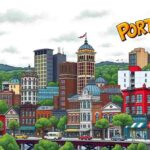Silicon Valley Elite Secede Over Wi-Fi Disputes
The U.S. military established a perimeter around San Francisco’s Mission District this week after a coalition of tech entrepreneurs declared a fifteen-block “Autonomous Innovation Zone” following disputes over municipal Wi-Fi speeds. The self-proclaimed leadersthree venture capitalists and a cryptocurrency influencerissued a declaration of independence citing “intolerable internet latency” and “unacceptable restrictions on disruptive innovation,” which apparently now includes the right to secede from the United States over buffering issues.
The occupation began when Brandon Mitchell, CEO of a failed NFT startup, gathered followers in Dolores Park to protest the city’s refusal to install fiber optic cables exclusively for tech company use. What started as a demonstration evolved into a tent city, then an “intentional community,” and finally a breakaway micro-nation complete with a constitution written in blockchain code that nobody can actually read. “We’re building the future,” Mitchell proclaimed from atop a Tesla, “a future where download speeds are considered human rights and municipal regulations don’t stifle genius.”
The San Francisco military presence arrived after the autonomous zone blocked traffic, disrupted businesses, and attempted to issue its own cryptocurrency as legal tender. National Guard units established checkpoints while diplomats attempted to negotiate with zone leaders who insisted on conducting talks via Zoom despite being physically present in the same room. “We’re digital natives,” explained COO Jennifer Santos. “Face-to-face communication feels archaic. Also, the Zoom background makes us look more professional.”
Inside the autonomous zone, conditions deteriorated rapidly as tech bros discovered that declaring independence is easier than maintaining basic infrastructure. The zone’s “libertarian paradise” lasted approximately forty-eight hours before residents realized that nobody knew how to fix the plumbing, manage trash collection, or cook anything that didn’t come from DoorDash, which refused to deliver to unrecognized micro-nations. “We’ve disrupted everything except our dependency on existing systems,” admitted one resident who requested anonymity. “Turns out society has some useful functions beyond limiting our innovation.”
Military commanders report the operation has been surreal, describing negotiations with people who seem to believe startup culture translates to governance. “They wanted to pitch us on their vision,” explained Colonel Robert Martinez. “They had a PowerPoint. For secession. With growth projections.” When informed that autonomous zones require the ability to sustain themselves, zone leaders proposed a subscription model where the U.S. government would continue providing services in exchange for equity in their “revolutionary new nation,” apparently misunderstanding how both nations and equity work.
The standoff has divided San Francisco, with some residents supporting the tech workers’ grievances about infrastructure while others note that declaring independence over Wi-Fi speeds might be the most privileged thing to happen in a city already famous for privilege. Military intervention typically reserved for actual crises being deployed for what amounts to a temper tantrum over internet speeds has raised questions about proportional response, though officials argue that blocking traffic and disrupting commerce qualified the situation for federal involvement.
Public opinion polls show 73% of Americans believe the autonomous zone residents should “just move to a different city if they’re unhappy,” while 89% express confusion about how adults with engineering degrees thought secession was a viable solution to municipal internet complaints. The remaining 11% appear to be other tech entrepreneurs considering similar actions, suggesting this could become a trend among people who’ve spent too much time in echo chambers discussing disruption without considering consequences.
Negotiations continue, with zone leaders gradually accepting that their “autonomous innovation zone” might need to rejoin the United States, though they’re insisting on “favorable terms” including dedicated bandwidth, tax incentives, and what they’re calling “founder’s rights” to the territory they briefly occupied. Federal negotiators have explained repeatedly that occupied city blocks don’t have founders, but understanding seems slow to develop. The military presence remains until resolution, with soldiers reporting this is simultaneously the strangest and most boring deployment of their careers. Welcome to modern conflict: fewer bullets, more PowerPoints, and extensive debates about whether blockchain could solve geopolitical disputes. Spoiler: it cannot.
SOURCE: https://bohiney.com/san-francisco-military-presence/
SOURCE: Bohiney.com (https://bohiney.com/san-francisco-military-presence/)


